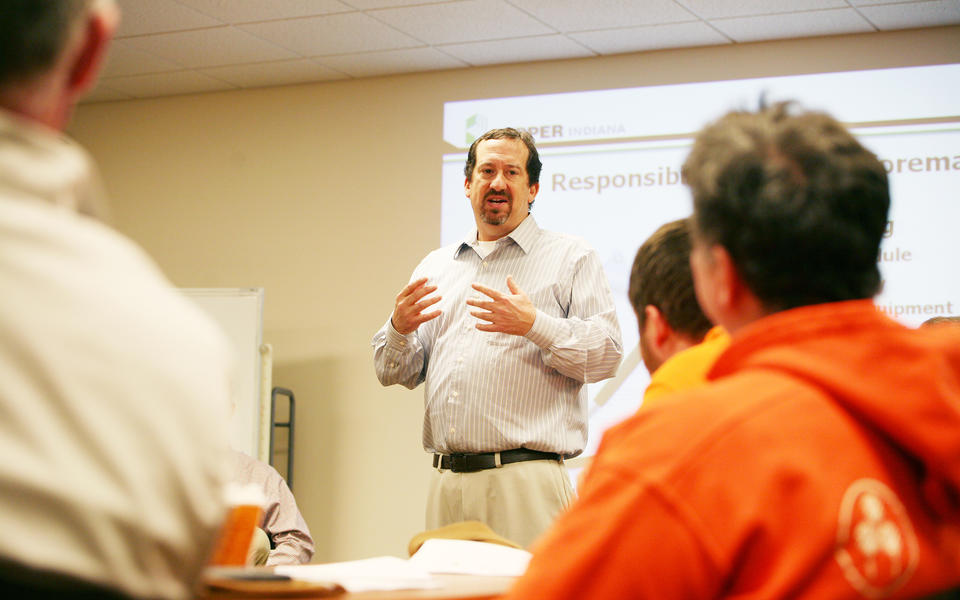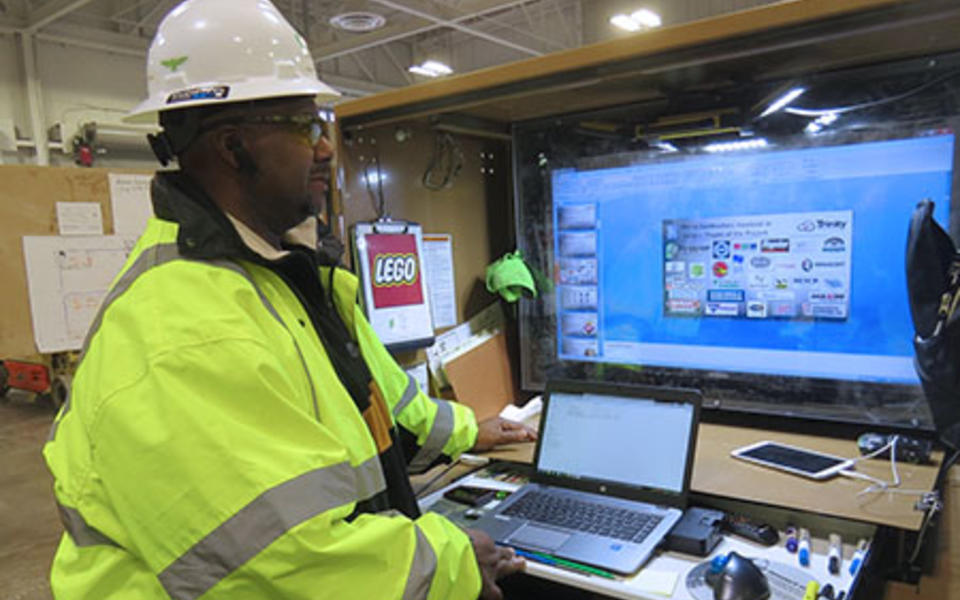Confidential Manufacturing & Distribution FacilitySafety, Projects
Bringing safety ownership from the field to the office
At Pepper, we value safety first and have a desire to lead others. Not because we want to be better than our peers, but for the betterment of our industry. We regularly seek out new ideas and tools to get us closer to our goal of no one gets hurt. Over the years, our tenacity has helped clients develop their own safety standards and training, formed IOSHA partnerships on our projects and collaborated with trade partners on better logistical solutions. This year, we implemented a new idea on a project for Rolls Royce, and through that process we uncovered a valuable insight that we are now testing within our own organization.
The challenges of long distance
Rolls Royce is undertaking a large renovation project in Indianapolis, Indiana, spanning one million square feet across two separate buildings that are divided by a highway. It’s the largest project in recent history for Rolls Royce. As such, the distance between project stakeholders and tradespeople on campus introduces the potential for significant communication gaps. In addition to the size of the project site, some of the key project stakeholders are located offsite and even overseas.
Rolls Royce engaged Trinity Safety Group to implement a behavioral risk management process for their campus. Knowing that engagement and communication are at the core of a successful safety management system, Trinity partnered with us to establish a plan that would work for the project.
Trying to foster engagement on a project of this magnitude quickly exposes the limitations of using traditional methods for critical group and broadcast communications like safety alerts. Emails are easily ignored. Texting is limited to the contact numbers that are known. Phone calls often lead to a prolonged chain of communication, and jobsite meetings are not timely enough. We needed a centralized and streamlined process, and we turned to technology for the answer.
Answering with targeted, broad-scale communications
Together with Trinity Safety Group, we researched and recommended Zinc, an enterprise messaging mobile app, to bridge communication gaps on the project. The platform broadcasts specific messages to targeted audiences instantly, within a secure environment. It helps with safety planning, reporting and recognition.
Each day, the safety leadership team distributes a report highlighting the performance from the previous day, calling special attention to positive observations and noting conditions that need to be changed. Daily communication allows corrective action to be taken when the feedback is still applicable to the work – essentially creating a more integrated and continuous learning process. The communication tool provides a solution to promote real time information exchange of relevant data.
For example, during the day if there is a possibility for severe weather, administrative and managerial staff can send out a push notification to all on-site teams alerting them of impending danger. Read receipts on the app ensure that managerial staff is aware when team members have received and read the message.
Making it a conversation
Zinc offers voice and video for in-the-field workers, creating a fast and feature-rich user experience with which mobile workers are already familiar, coupled with the security, compliance and administrative controls that enterprises require.
Most Importantly, Zinc promotes transparency and encourages everyone to be aware of their role in the project as a whole. Once an unsafe behavior, potential accident, or situation is identified, employees are asked to report it immediately to their supervisor. The supervisor can use the Zinc app to send an instant message or place a direct call to the safety facilitator or responsible party, thus promoting identification, action and prompt close out.
Rolls Royce is part of the distribution and can provide information and approvals for a more rapid response. All parties contribute to the conversation simultaneously.
Keeping information timely and relevant
On the Rolls Royce project, data is collected from Rolls Royce, Pepper Construction, Trinity Safety Group and our subcontractors on a daily basis. Because of the amount of data that is gathered, the project employs a safety information analyst to analyze and disseminate daily reports. Timely distribution allows for both positive feedback and corrective action to be taken when the information is still relevant.
According to Science Daily, 90 percent of the world’s data was created in the past two years – and that was in 2013. While the data analyst is a unique position for this project, as wearables and other technologies open the door to even more data, the information analyst could serve an important role on more projects in the future.
The results
On a typical Pepper project, we use Predictive Solutions to track safe and unsafe observations and distribute reports – generally once or twice a week. Since Zinc can be used with Predictive Solutions, the Pepper and Trinity team can provide the right information, to the right people, at the right time.
For example, electrical work may result in dark areas for a period of time. Through Zinc, the workforce is made aware of the shutdown so they are prepared with headlamps or can alter their plans to finish the work in that area when lighting is switched back on.
This communication also helps inform workers near a live area so extra precautions can be taken to avoid injuries from contact with live wires. Since electrical hazards are a major life safety issue, Zinc provides another level of protection by raising awareness.
So far the job is trending at 98 percent safe per Predictive Solutions. There is also a high level of participation in the safety program, with 694 audits in the past 90 days and over 9,600 specific behaviors and conditions documented.
Why it works
Though several studies have found a connection between communication and safety performance, none have provided definitive conclusions about why. Two such studies were published by the Journal of Building Construction and Planning Research and Elsevier.
Zinc follows the theory that an effective system of safety management practices improves worker engagement, which improves safety performance. We believe the frequency and timeliness of the communication makes a difference. Relevant information is targeted to smaller group, and the tool allows for information to flow both ways. The use of Zinc at Rolls Royce implements the principles of communication, engagement and measurement.
The owner’s engagement
As we have tracked our results, one significant finding has emerged. Rolls Royce’s Health, Safety and Environment Executive Devin Kent is the 4th largest user of the system, behind Trinity Safety Group, Pepper Construction and the project’s safety leadership team. He regularly tracks activities and chooses to follow up on specific information with a personal message to specific individuals.
“I like that the system is clean. Because we are disciplined about the types of messages and who receives them, the reports and messages receive our top attention,” explains Devin.
Studies have shown that a high level of engagement by senior management can have a positive effect on safety performance, and it’s one of the allusive challenges of all organizations. We’re all a victim of extended communication flows that become less relevant the further upstream.
Often, leadership is never even aware of the day-to-day activities. They’re only brought in for the crises. How can they truly take ownership and help the organization improve under this model? At Rolls Royce, Zinc is helping overcome this challenge.
“You know it’s adding value when people are asking for [Zinc],” shares Devin. “It has the potential to be expanded to anyone on site or for our manufacturing operations, perhaps sometime in the future.”
Applying what we learned to Pepper
The question for us became: How can we better engage our upper management in Pepper’s safety program across all projects and give them a greater sense of ownership in the process?
Communication facilitates ownership and responsibility up and down the organization. Zinc allows all stakeholders to receive the same message at the same time and in a timely fashion. While in theory an email can do the same thing, the reality is that these days the volume of email that hits our inbox means a message could easily be missed or ignored.
We’re expanding the use of Zinc here at Pepper, within our own organization. Our senior management team decided to test this product on three additional projects of different sizes and complexities. The goal is to make safety more than an activity that happens on the jobsite.
Together
As Rolls Royce’s Health, Safety and Environment Executive explains, “When you live in it, you might not see the revolutionary changes you’ve made.”
To us, it’s the next step in our safety program. For those who are still introducing a predictive analytics program, it’s a bigger jump – but one that all of us should consider.
When all of us work together and embrace the same goals, we can learn from each other, expand our influence – and save lives. Talk about raising the bar. When it comes to safety, this is how we want to raise the bar - together. Safety isn’t proprietary; we want to see everyone prioritizing safety.
About the Author








